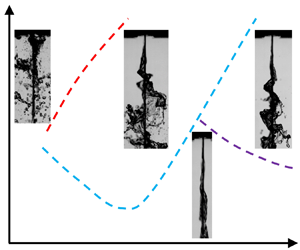Article contents
Experimental study on the oscillatory Kelvin–Helmholtz instability of a planar liquid sheet in the presence of axial oscillating gas flow
Published online by Cambridge University Press: 17 March 2023
Abstract

The oscillatory Kelvin–Helmholtz (K–H) instability of a planar liquid sheet was experimentally investigated in the presence of an axial oscillating gas flow. An experimental system was initiated to study the oscillatory K–H instability. The surface wave growth rates were measured and compared with theoretical results obtained using the authors’ early linear method. Furthermore, in a larger parameter range experimentally studied, it is interesting that there are four different unstable modes: first disordered mode (FDM), second disordered mode (SDM), K–H harmonic unstable mode (KHH) and K–H subharmonic unstable mode (KHS). These unstable modes are determined by the oscillating amplitude, oscillating frequency and liquid inertia force. The frequencies of KHH are equal to the oscillating frequency; the frequency of KHS equals half the oscillating frequency, while the frequencies of FDM and SDM are irregular. By considering the mechanism of instability, the instability regime maps on the relative Weber number versus liquid Weber number (Werel–Wel) and the Weber number ratio versus the oscillating frequency (Werel/Wel– $\varOmega$s2) were plotted. Among these four modes, KHS is the most unexpected: the frequency of this mode is not equal to the oscillating frequency, but the surface wave can also couple with the oscillating gas flow. Linear instability theory was applied to divide the parameter range between the different unstable modes. According to linear instability theory, K–H and parametric unstable regions both exist. However, note that all four modes (KHH, KHS, FDM and SDM) corresponded primarily to the K–H unstable region obtained from the theoretical analysis. Nevertheless, the parametric unstable mode was also observed when the oscillating frequency and amplitude were relatively low, and the liquid inertia force was relatively high. The surface wave amplitude was small but regular, and the evolution of this wave was similar to that of Faraday waves. The wave oscillating frequency was half that of the surface wave.
$\varOmega$s2) were plotted. Among these four modes, KHS is the most unexpected: the frequency of this mode is not equal to the oscillating frequency, but the surface wave can also couple with the oscillating gas flow. Linear instability theory was applied to divide the parameter range between the different unstable modes. According to linear instability theory, K–H and parametric unstable regions both exist. However, note that all four modes (KHH, KHS, FDM and SDM) corresponded primarily to the K–H unstable region obtained from the theoretical analysis. Nevertheless, the parametric unstable mode was also observed when the oscillating frequency and amplitude were relatively low, and the liquid inertia force was relatively high. The surface wave amplitude was small but regular, and the evolution of this wave was similar to that of Faraday waves. The wave oscillating frequency was half that of the surface wave.
Information
- Type
- JFM Papers
- Information
- Copyright
- © The Author(s), 2023. Published by Cambridge University Press
References
- 15
- Cited by


